Consumer Rights Act 2015 Analysis: Goods, Services, and Remedies
VerifiedAdded on 2023/06/04
|8
|2293
|239
Homework Assignment
AI Summary
This document analyzes the Consumer Rights Act 2015, focusing on the rights and remedies available to consumers in the UK. The assignment addresses key aspects of the Act, including implied terms related to the sale and supply of goods and services, such as satisfactory quality, fitness for purpose, and matching descriptions. It examines the rights of consumers regarding faulty goods, including the right to reject goods within 30 days, the right to repair or replacement, and the right to a price reduction or rejection after unsuccessful attempts at repair or replacement. The document also clarifies the definition of 'goods' under the Act and outlines the exclusions to consumer rights. Furthermore, the assignment outlines the changes introduced by the Act regarding consumer remedies, including the short-term right to reject, repair or replacement, and the final right to reject. The assignment also discusses the standards goods, whether physical or digital, must meet, including satisfactory quality, fitness for purpose, and matching descriptions. The assignment concludes by referencing legal scholars to support the findings. Overall, the document provides a comprehensive overview of the Consumer Rights Act 2015 and its implications for consumers.
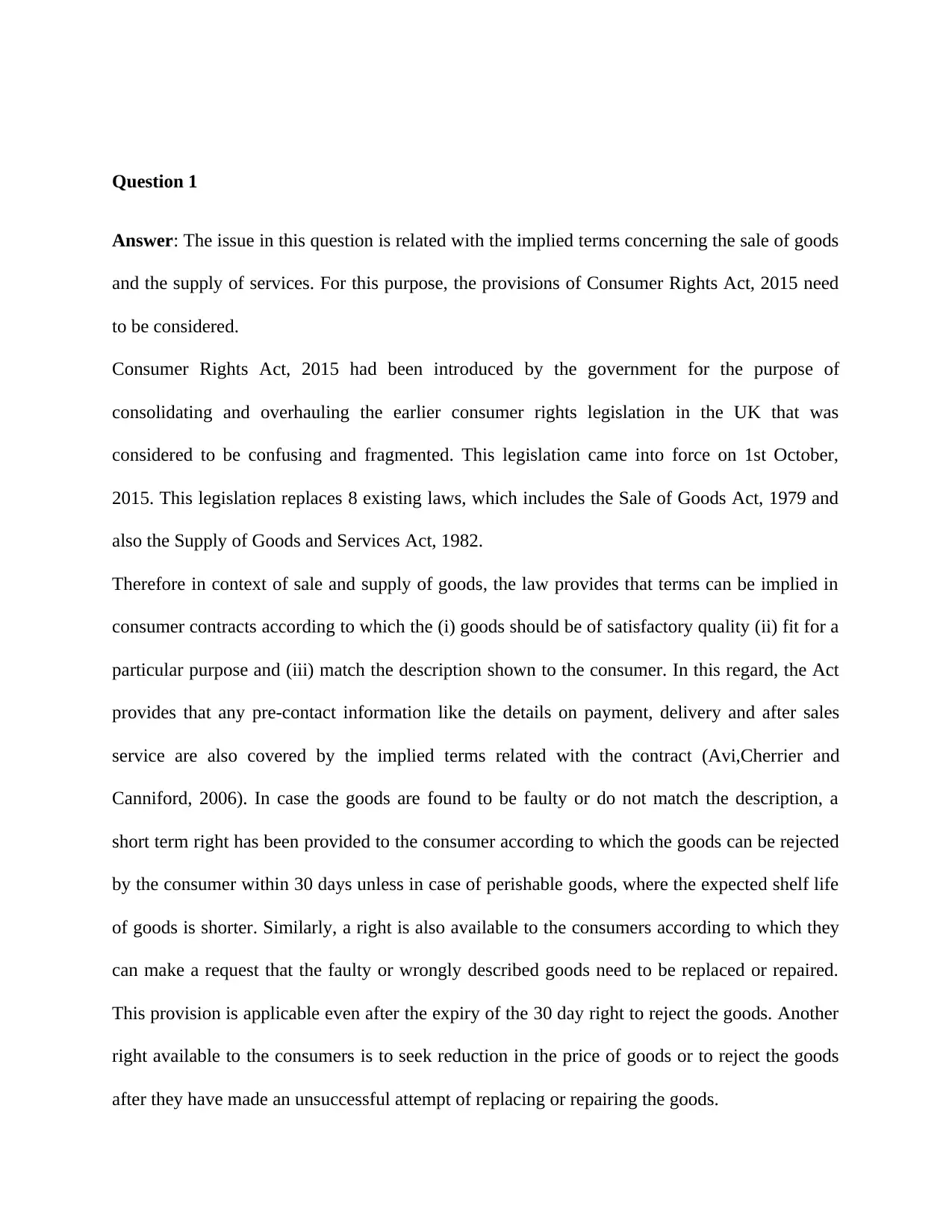
Question 1
Answer: The issue in this question is related with the implied terms concerning the sale of goods
and the supply of services. For this purpose, the provisions of Consumer Rights Act, 2015 need
to be considered.
Consumer Rights Act, 2015 had been introduced by the government for the purpose of
consolidating and overhauling the earlier consumer rights legislation in the UK that was
considered to be confusing and fragmented. This legislation came into force on 1st October,
2015. This legislation replaces 8 existing laws, which includes the Sale of Goods Act, 1979 and
also the Supply of Goods and Services Act, 1982.
Therefore in context of sale and supply of goods, the law provides that terms can be implied in
consumer contracts according to which the (i) goods should be of satisfactory quality (ii) fit for a
particular purpose and (iii) match the description shown to the consumer. In this regard, the Act
provides that any pre-contact information like the details on payment, delivery and after sales
service are also covered by the implied terms related with the contract (Avi,Cherrier and
Canniford, 2006). In case the goods are found to be faulty or do not match the description, a
short term right has been provided to the consumer according to which the goods can be rejected
by the consumer within 30 days unless in case of perishable goods, where the expected shelf life
of goods is shorter. Similarly, a right is also available to the consumers according to which they
can make a request that the faulty or wrongly described goods need to be replaced or repaired.
This provision is applicable even after the expiry of the 30 day right to reject the goods. Another
right available to the consumers is to seek reduction in the price of goods or to reject the goods
after they have made an unsuccessful attempt of replacing or repairing the goods.
Answer: The issue in this question is related with the implied terms concerning the sale of goods
and the supply of services. For this purpose, the provisions of Consumer Rights Act, 2015 need
to be considered.
Consumer Rights Act, 2015 had been introduced by the government for the purpose of
consolidating and overhauling the earlier consumer rights legislation in the UK that was
considered to be confusing and fragmented. This legislation came into force on 1st October,
2015. This legislation replaces 8 existing laws, which includes the Sale of Goods Act, 1979 and
also the Supply of Goods and Services Act, 1982.
Therefore in context of sale and supply of goods, the law provides that terms can be implied in
consumer contracts according to which the (i) goods should be of satisfactory quality (ii) fit for a
particular purpose and (iii) match the description shown to the consumer. In this regard, the Act
provides that any pre-contact information like the details on payment, delivery and after sales
service are also covered by the implied terms related with the contract (Avi,Cherrier and
Canniford, 2006). In case the goods are found to be faulty or do not match the description, a
short term right has been provided to the consumer according to which the goods can be rejected
by the consumer within 30 days unless in case of perishable goods, where the expected shelf life
of goods is shorter. Similarly, a right is also available to the consumers according to which they
can make a request that the faulty or wrongly described goods need to be replaced or repaired.
This provision is applicable even after the expiry of the 30 day right to reject the goods. Another
right available to the consumers is to seek reduction in the price of goods or to reject the goods
after they have made an unsuccessful attempt of replacing or repairing the goods.
Secure Best Marks with AI Grader
Need help grading? Try our AI Grader for instant feedback on your assignments.
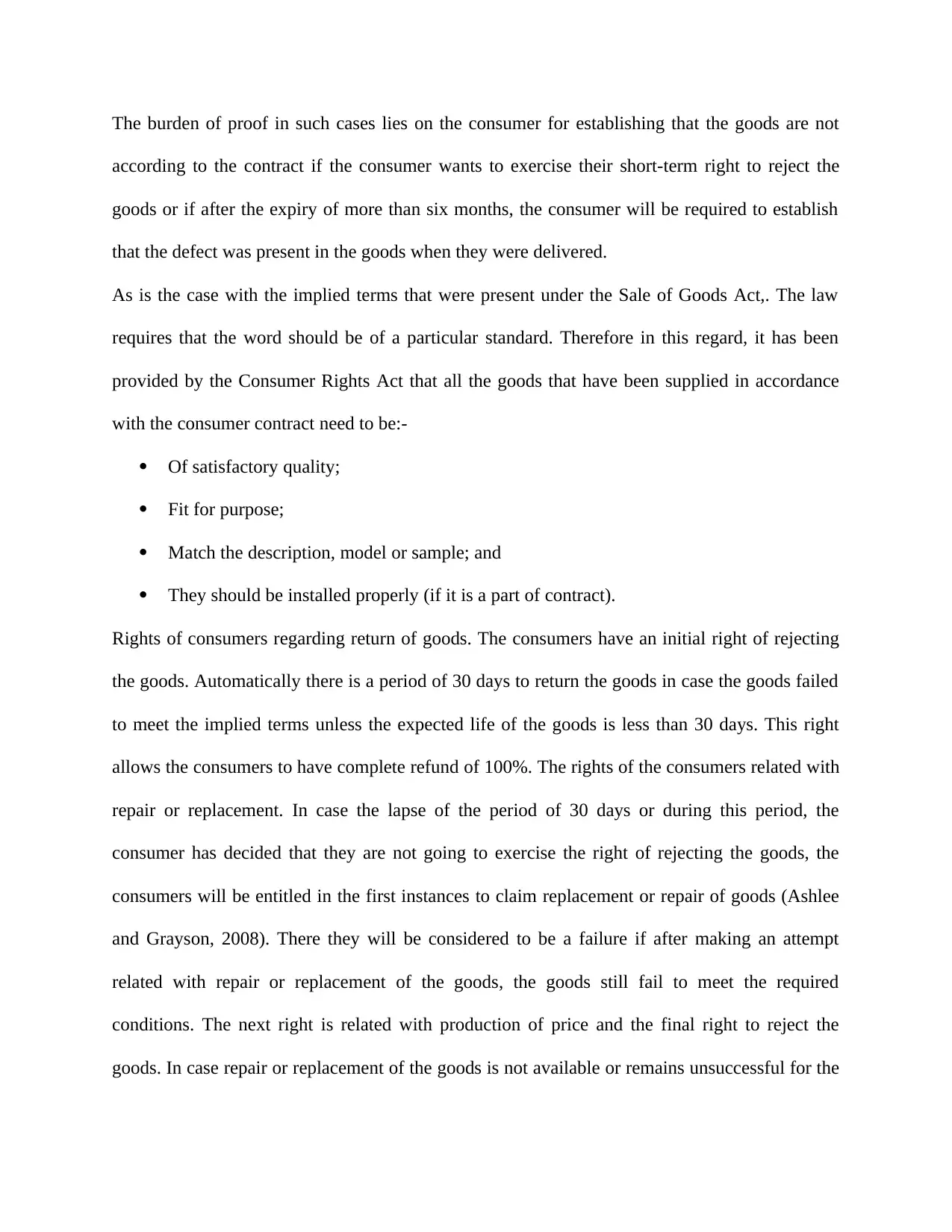
The burden of proof in such cases lies on the consumer for establishing that the goods are not
according to the contract if the consumer wants to exercise their short-term right to reject the
goods or if after the expiry of more than six months, the consumer will be required to establish
that the defect was present in the goods when they were delivered.
As is the case with the implied terms that were present under the Sale of Goods Act,. The law
requires that the word should be of a particular standard. Therefore in this regard, it has been
provided by the Consumer Rights Act that all the goods that have been supplied in accordance
with the consumer contract need to be:-
Of satisfactory quality;
Fit for purpose;
Match the description, model or sample; and
They should be installed properly (if it is a part of contract).
Rights of consumers regarding return of goods. The consumers have an initial right of rejecting
the goods. Automatically there is a period of 30 days to return the goods in case the goods failed
to meet the implied terms unless the expected life of the goods is less than 30 days. This right
allows the consumers to have complete refund of 100%. The rights of the consumers related with
repair or replacement. In case the lapse of the period of 30 days or during this period, the
consumer has decided that they are not going to exercise the right of rejecting the goods, the
consumers will be entitled in the first instances to claim replacement or repair of goods (Ashlee
and Grayson, 2008). There they will be considered to be a failure if after making an attempt
related with repair or replacement of the goods, the goods still fail to meet the required
conditions. The next right is related with production of price and the final right to reject the
goods. In case repair or replacement of the goods is not available or remains unsuccessful for the
according to the contract if the consumer wants to exercise their short-term right to reject the
goods or if after the expiry of more than six months, the consumer will be required to establish
that the defect was present in the goods when they were delivered.
As is the case with the implied terms that were present under the Sale of Goods Act,. The law
requires that the word should be of a particular standard. Therefore in this regard, it has been
provided by the Consumer Rights Act that all the goods that have been supplied in accordance
with the consumer contract need to be:-
Of satisfactory quality;
Fit for purpose;
Match the description, model or sample; and
They should be installed properly (if it is a part of contract).
Rights of consumers regarding return of goods. The consumers have an initial right of rejecting
the goods. Automatically there is a period of 30 days to return the goods in case the goods failed
to meet the implied terms unless the expected life of the goods is less than 30 days. This right
allows the consumers to have complete refund of 100%. The rights of the consumers related with
repair or replacement. In case the lapse of the period of 30 days or during this period, the
consumer has decided that they are not going to exercise the right of rejecting the goods, the
consumers will be entitled in the first instances to claim replacement or repair of goods (Ashlee
and Grayson, 2008). There they will be considered to be a failure if after making an attempt
related with repair or replacement of the goods, the goods still fail to meet the required
conditions. The next right is related with production of price and the final right to reject the
goods. In case repair or replacement of the goods is not available or remains unsuccessful for the
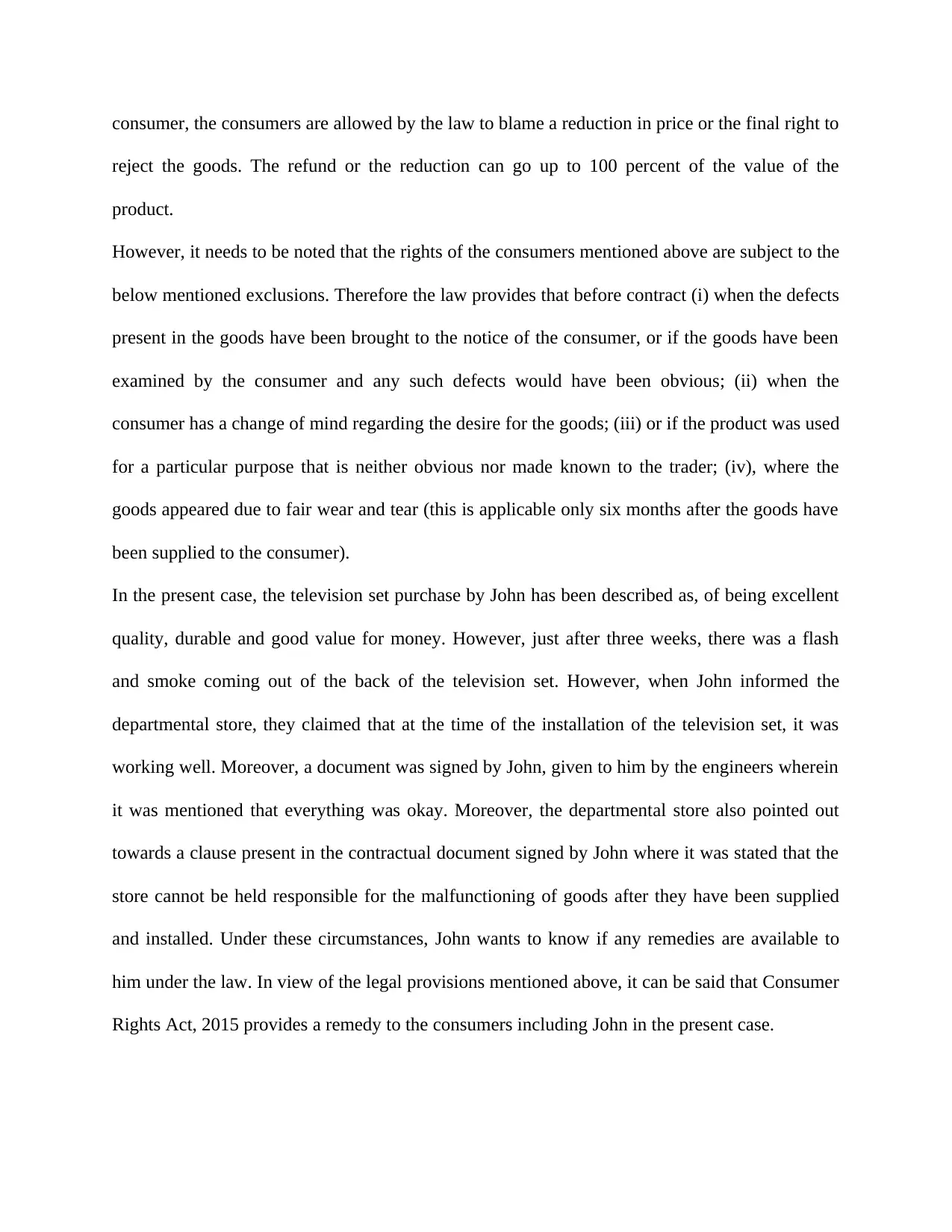
consumer, the consumers are allowed by the law to blame a reduction in price or the final right to
reject the goods. The refund or the reduction can go up to 100 percent of the value of the
product.
However, it needs to be noted that the rights of the consumers mentioned above are subject to the
below mentioned exclusions. Therefore the law provides that before contract (i) when the defects
present in the goods have been brought to the notice of the consumer, or if the goods have been
examined by the consumer and any such defects would have been obvious; (ii) when the
consumer has a change of mind regarding the desire for the goods; (iii) or if the product was used
for a particular purpose that is neither obvious nor made known to the trader; (iv), where the
goods appeared due to fair wear and tear (this is applicable only six months after the goods have
been supplied to the consumer).
In the present case, the television set purchase by John has been described as, of being excellent
quality, durable and good value for money. However, just after three weeks, there was a flash
and smoke coming out of the back of the television set. However, when John informed the
departmental store, they claimed that at the time of the installation of the television set, it was
working well. Moreover, a document was signed by John, given to him by the engineers wherein
it was mentioned that everything was okay. Moreover, the departmental store also pointed out
towards a clause present in the contractual document signed by John where it was stated that the
store cannot be held responsible for the malfunctioning of goods after they have been supplied
and installed. Under these circumstances, John wants to know if any remedies are available to
him under the law. In view of the legal provisions mentioned above, it can be said that Consumer
Rights Act, 2015 provides a remedy to the consumers including John in the present case.
reject the goods. The refund or the reduction can go up to 100 percent of the value of the
product.
However, it needs to be noted that the rights of the consumers mentioned above are subject to the
below mentioned exclusions. Therefore the law provides that before contract (i) when the defects
present in the goods have been brought to the notice of the consumer, or if the goods have been
examined by the consumer and any such defects would have been obvious; (ii) when the
consumer has a change of mind regarding the desire for the goods; (iii) or if the product was used
for a particular purpose that is neither obvious nor made known to the trader; (iv), where the
goods appeared due to fair wear and tear (this is applicable only six months after the goods have
been supplied to the consumer).
In the present case, the television set purchase by John has been described as, of being excellent
quality, durable and good value for money. However, just after three weeks, there was a flash
and smoke coming out of the back of the television set. However, when John informed the
departmental store, they claimed that at the time of the installation of the television set, it was
working well. Moreover, a document was signed by John, given to him by the engineers wherein
it was mentioned that everything was okay. Moreover, the departmental store also pointed out
towards a clause present in the contractual document signed by John where it was stated that the
store cannot be held responsible for the malfunctioning of goods after they have been supplied
and installed. Under these circumstances, John wants to know if any remedies are available to
him under the law. In view of the legal provisions mentioned above, it can be said that Consumer
Rights Act, 2015 provides a remedy to the consumers including John in the present case.
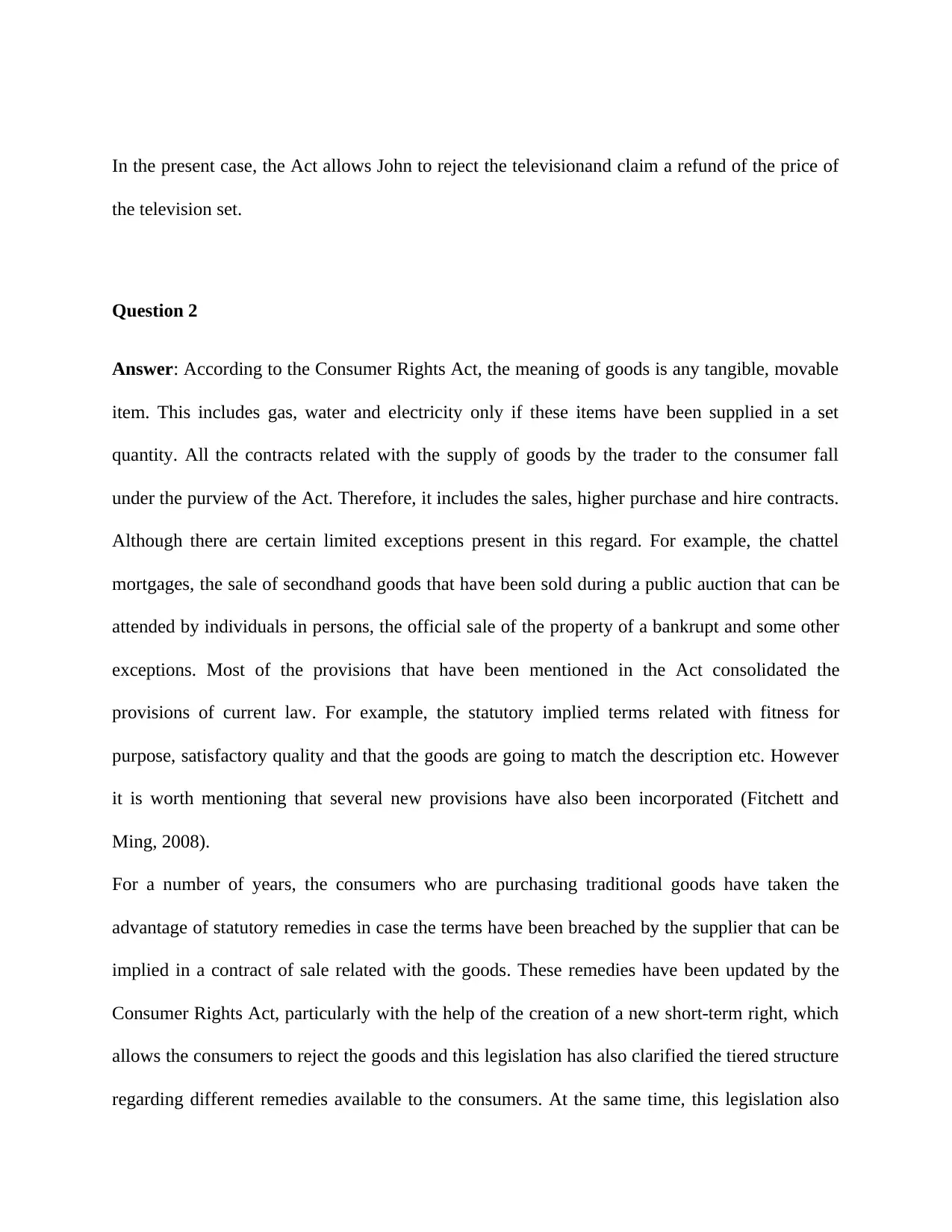
In the present case, the Act allows John to reject the televisionand claim a refund of the price of
the television set.
Question 2
Answer: According to the Consumer Rights Act, the meaning of goods is any tangible, movable
item. This includes gas, water and electricity only if these items have been supplied in a set
quantity. All the contracts related with the supply of goods by the trader to the consumer fall
under the purview of the Act. Therefore, it includes the sales, higher purchase and hire contracts.
Although there are certain limited exceptions present in this regard. For example, the chattel
mortgages, the sale of secondhand goods that have been sold during a public auction that can be
attended by individuals in persons, the official sale of the property of a bankrupt and some other
exceptions. Most of the provisions that have been mentioned in the Act consolidated the
provisions of current law. For example, the statutory implied terms related with fitness for
purpose, satisfactory quality and that the goods are going to match the description etc. However
it is worth mentioning that several new provisions have also been incorporated (Fitchett and
Ming, 2008).
For a number of years, the consumers who are purchasing traditional goods have taken the
advantage of statutory remedies in case the terms have been breached by the supplier that can be
implied in a contract of sale related with the goods. These remedies have been updated by the
Consumer Rights Act, particularly with the help of the creation of a new short-term right, which
allows the consumers to reject the goods and this legislation has also clarified the tiered structure
regarding different remedies available to the consumers. At the same time, this legislation also
the television set.
Question 2
Answer: According to the Consumer Rights Act, the meaning of goods is any tangible, movable
item. This includes gas, water and electricity only if these items have been supplied in a set
quantity. All the contracts related with the supply of goods by the trader to the consumer fall
under the purview of the Act. Therefore, it includes the sales, higher purchase and hire contracts.
Although there are certain limited exceptions present in this regard. For example, the chattel
mortgages, the sale of secondhand goods that have been sold during a public auction that can be
attended by individuals in persons, the official sale of the property of a bankrupt and some other
exceptions. Most of the provisions that have been mentioned in the Act consolidated the
provisions of current law. For example, the statutory implied terms related with fitness for
purpose, satisfactory quality and that the goods are going to match the description etc. However
it is worth mentioning that several new provisions have also been incorporated (Fitchett and
Ming, 2008).
For a number of years, the consumers who are purchasing traditional goods have taken the
advantage of statutory remedies in case the terms have been breached by the supplier that can be
implied in a contract of sale related with the goods. These remedies have been updated by the
Consumer Rights Act, particularly with the help of the creation of a new short-term right, which
allows the consumers to reject the goods and this legislation has also clarified the tiered structure
regarding different remedies available to the consumers. At the same time, this legislation also
Secure Best Marks with AI Grader
Need help grading? Try our AI Grader for instant feedback on your assignments.
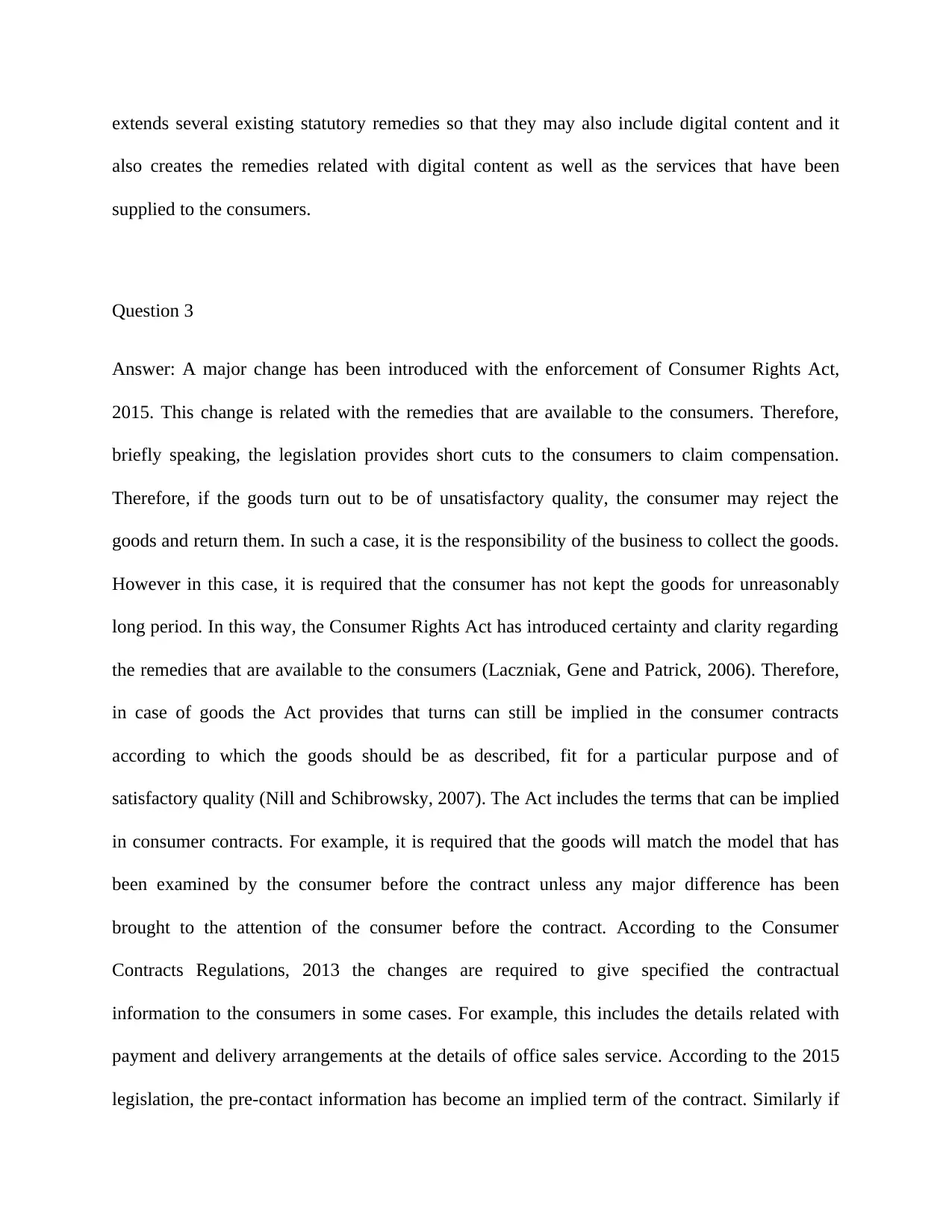
extends several existing statutory remedies so that they may also include digital content and it
also creates the remedies related with digital content as well as the services that have been
supplied to the consumers.
Question 3
Answer: A major change has been introduced with the enforcement of Consumer Rights Act,
2015. This change is related with the remedies that are available to the consumers. Therefore,
briefly speaking, the legislation provides short cuts to the consumers to claim compensation.
Therefore, if the goods turn out to be of unsatisfactory quality, the consumer may reject the
goods and return them. In such a case, it is the responsibility of the business to collect the goods.
However in this case, it is required that the consumer has not kept the goods for unreasonably
long period. In this way, the Consumer Rights Act has introduced certainty and clarity regarding
the remedies that are available to the consumers (Laczniak, Gene and Patrick, 2006). Therefore,
in case of goods the Act provides that turns can still be implied in the consumer contracts
according to which the goods should be as described, fit for a particular purpose and of
satisfactory quality (Nill and Schibrowsky, 2007). The Act includes the terms that can be implied
in consumer contracts. For example, it is required that the goods will match the model that has
been examined by the consumer before the contract unless any major difference has been
brought to the attention of the consumer before the contract. According to the Consumer
Contracts Regulations, 2013 the changes are required to give specified the contractual
information to the consumers in some cases. For example, this includes the details related with
payment and delivery arrangements at the details of office sales service. According to the 2015
legislation, the pre-contact information has become an implied term of the contract. Similarly if
also creates the remedies related with digital content as well as the services that have been
supplied to the consumers.
Question 3
Answer: A major change has been introduced with the enforcement of Consumer Rights Act,
2015. This change is related with the remedies that are available to the consumers. Therefore,
briefly speaking, the legislation provides short cuts to the consumers to claim compensation.
Therefore, if the goods turn out to be of unsatisfactory quality, the consumer may reject the
goods and return them. In such a case, it is the responsibility of the business to collect the goods.
However in this case, it is required that the consumer has not kept the goods for unreasonably
long period. In this way, the Consumer Rights Act has introduced certainty and clarity regarding
the remedies that are available to the consumers (Laczniak, Gene and Patrick, 2006). Therefore,
in case of goods the Act provides that turns can still be implied in the consumer contracts
according to which the goods should be as described, fit for a particular purpose and of
satisfactory quality (Nill and Schibrowsky, 2007). The Act includes the terms that can be implied
in consumer contracts. For example, it is required that the goods will match the model that has
been examined by the consumer before the contract unless any major difference has been
brought to the attention of the consumer before the contract. According to the Consumer
Contracts Regulations, 2013 the changes are required to give specified the contractual
information to the consumers in some cases. For example, this includes the details related with
payment and delivery arrangements at the details of office sales service. According to the 2015
legislation, the pre-contact information has become an implied term of the contract. Similarly if
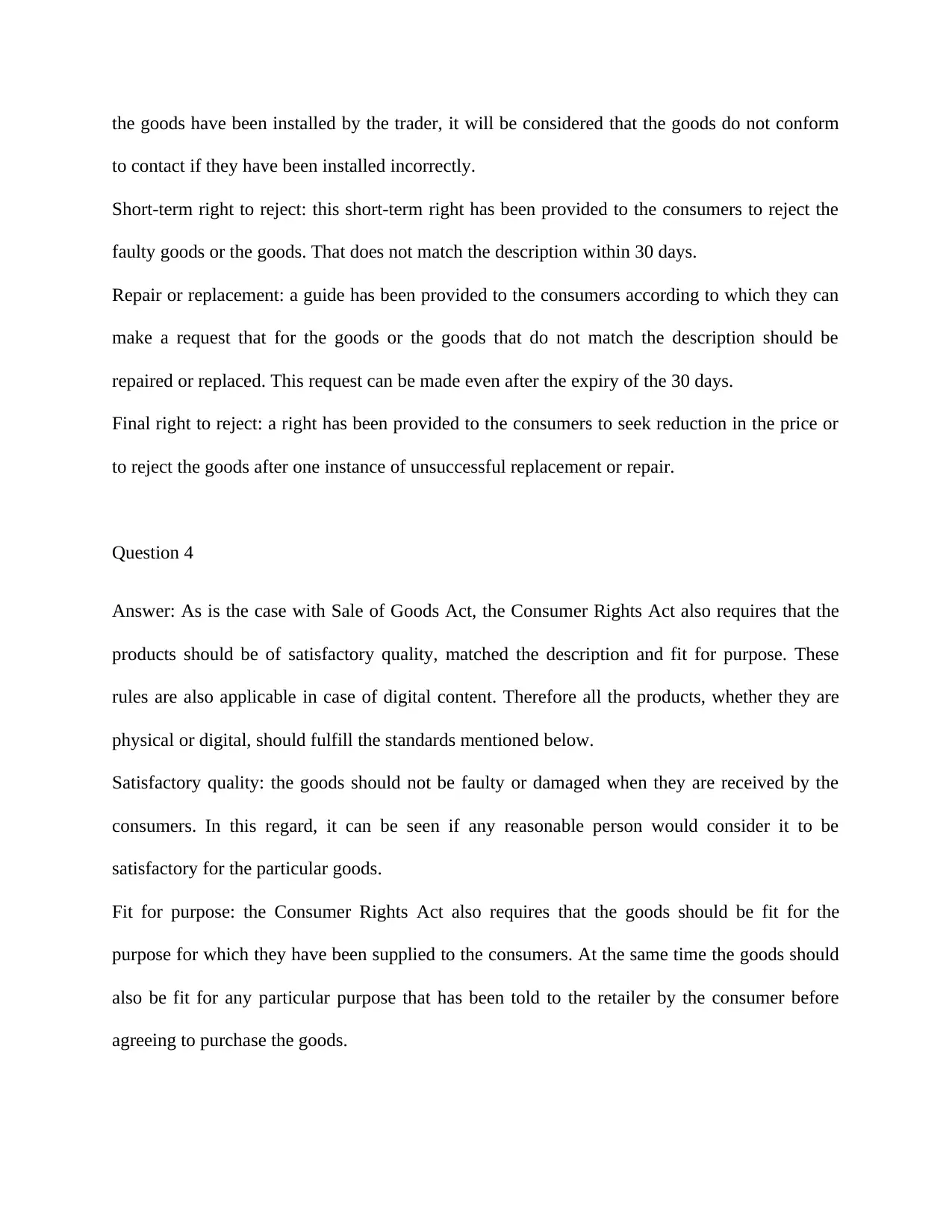
the goods have been installed by the trader, it will be considered that the goods do not conform
to contact if they have been installed incorrectly.
Short-term right to reject: this short-term right has been provided to the consumers to reject the
faulty goods or the goods. That does not match the description within 30 days.
Repair or replacement: a guide has been provided to the consumers according to which they can
make a request that for the goods or the goods that do not match the description should be
repaired or replaced. This request can be made even after the expiry of the 30 days.
Final right to reject: a right has been provided to the consumers to seek reduction in the price or
to reject the goods after one instance of unsuccessful replacement or repair.
Question 4
Answer: As is the case with Sale of Goods Act, the Consumer Rights Act also requires that the
products should be of satisfactory quality, matched the description and fit for purpose. These
rules are also applicable in case of digital content. Therefore all the products, whether they are
physical or digital, should fulfill the standards mentioned below.
Satisfactory quality: the goods should not be faulty or damaged when they are received by the
consumers. In this regard, it can be seen if any reasonable person would consider it to be
satisfactory for the particular goods.
Fit for purpose: the Consumer Rights Act also requires that the goods should be fit for the
purpose for which they have been supplied to the consumers. At the same time the goods should
also be fit for any particular purpose that has been told to the retailer by the consumer before
agreeing to purchase the goods.
to contact if they have been installed incorrectly.
Short-term right to reject: this short-term right has been provided to the consumers to reject the
faulty goods or the goods. That does not match the description within 30 days.
Repair or replacement: a guide has been provided to the consumers according to which they can
make a request that for the goods or the goods that do not match the description should be
repaired or replaced. This request can be made even after the expiry of the 30 days.
Final right to reject: a right has been provided to the consumers to seek reduction in the price or
to reject the goods after one instance of unsuccessful replacement or repair.
Question 4
Answer: As is the case with Sale of Goods Act, the Consumer Rights Act also requires that the
products should be of satisfactory quality, matched the description and fit for purpose. These
rules are also applicable in case of digital content. Therefore all the products, whether they are
physical or digital, should fulfill the standards mentioned below.
Satisfactory quality: the goods should not be faulty or damaged when they are received by the
consumers. In this regard, it can be seen if any reasonable person would consider it to be
satisfactory for the particular goods.
Fit for purpose: the Consumer Rights Act also requires that the goods should be fit for the
purpose for which they have been supplied to the consumers. At the same time the goods should
also be fit for any particular purpose that has been told to the retailer by the consumer before
agreeing to purchase the goods.

Match the description: it is also required under the law that the goods supplied to the consumer
should match the description that has been given to the consumer or any sample or model that
has been shown to the consumer before purchasing the goods.
should match the description that has been given to the consumer or any sample or model that
has been shown to the consumer before purchasing the goods.
Paraphrase This Document
Need a fresh take? Get an instant paraphrase of this document with our AI Paraphraser
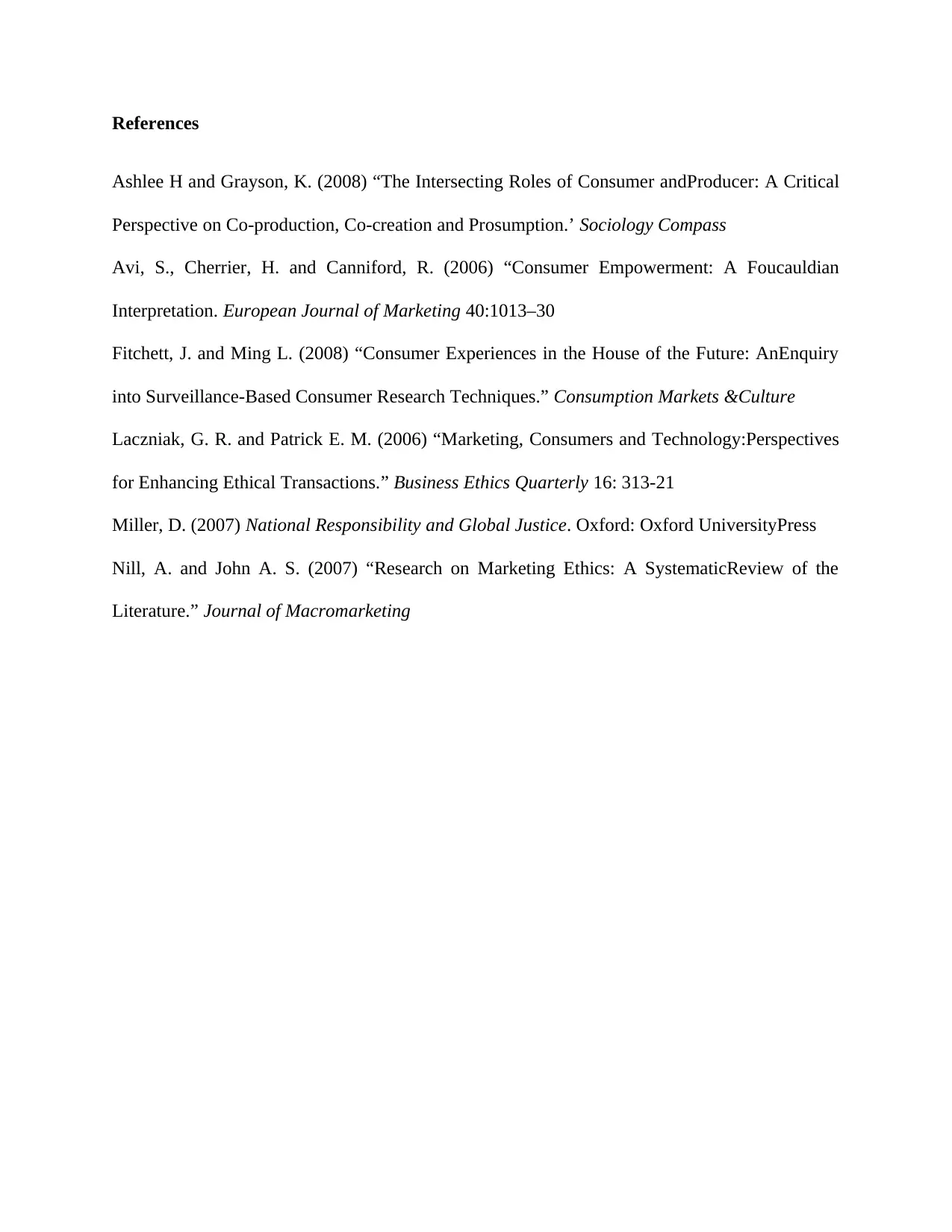
References
Ashlee H and Grayson, K. (2008) “The Intersecting Roles of Consumer andProducer: A Critical
Perspective on Co-production, Co-creation and Prosumption.’ Sociology Compass
Avi, S., Cherrier, H. and Canniford, R. (2006) “Consumer Empowerment: A Foucauldian
Interpretation. European Journal of Marketing 40:1013–30
Fitchett, J. and Ming L. (2008) “Consumer Experiences in the House of the Future: AnEnquiry
into Surveillance-Based Consumer Research Techniques.” Consumption Markets &Culture
Laczniak, G. R. and Patrick E. M. (2006) “Marketing, Consumers and Technology:Perspectives
for Enhancing Ethical Transactions.” Business Ethics Quarterly 16: 313-21
Miller, D. (2007) National Responsibility and Global Justice. Oxford: Oxford UniversityPress
Nill, A. and John A. S. (2007) “Research on Marketing Ethics: A SystematicReview of the
Literature.” Journal of Macromarketing
Ashlee H and Grayson, K. (2008) “The Intersecting Roles of Consumer andProducer: A Critical
Perspective on Co-production, Co-creation and Prosumption.’ Sociology Compass
Avi, S., Cherrier, H. and Canniford, R. (2006) “Consumer Empowerment: A Foucauldian
Interpretation. European Journal of Marketing 40:1013–30
Fitchett, J. and Ming L. (2008) “Consumer Experiences in the House of the Future: AnEnquiry
into Surveillance-Based Consumer Research Techniques.” Consumption Markets &Culture
Laczniak, G. R. and Patrick E. M. (2006) “Marketing, Consumers and Technology:Perspectives
for Enhancing Ethical Transactions.” Business Ethics Quarterly 16: 313-21
Miller, D. (2007) National Responsibility and Global Justice. Oxford: Oxford UniversityPress
Nill, A. and John A. S. (2007) “Research on Marketing Ethics: A SystematicReview of the
Literature.” Journal of Macromarketing
1 out of 8
Related Documents
Your All-in-One AI-Powered Toolkit for Academic Success.
+13062052269
info@desklib.com
Available 24*7 on WhatsApp / Email
![[object Object]](/_next/static/media/star-bottom.7253800d.svg)
Unlock your academic potential
© 2024 | Zucol Services PVT LTD | All rights reserved.





